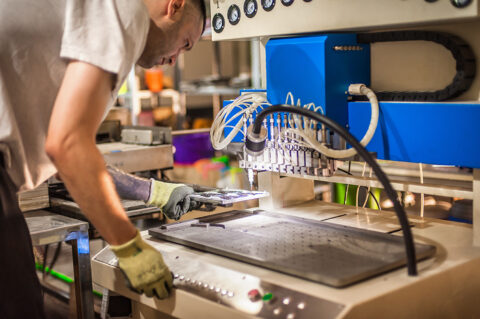Strategic Realignment Meets Market Friction
Major players are doubling down on domestic production, even as warning signs flash across key supply chains. The headlines were big: a $4 billion reinvestment in domestic auto production, intensifying chip export controls targeting Chinese supply chains, and new signs of strain in factory output and EV battery demand. Taken together, these developments highlight the tension at the heart of the U.S. manufacturing resurgence—a push to rebuild domestic capacity while navigating shifting global alliances, market volatility, and the realities of long-term transformation.
On one hand, we’re seeing serious momentum. General Motors’ $4 billion commitment to U.S. plants sends a clear signal that even the biggest OEMs are recalibrating for a future where localized production isn’t just patriotic—it’s pragmatic. Meanwhile, the Commerce Department’s plan to roll back chip export waivers for major Asian manufacturers operating in China shows how national security is reshaping trade policy in real time. These aren’t isolated decisions—they’re part of a broader shift toward resilience, optionality, and control over critical supply chains.
But the challenges remain real. Factory output fell again in May, with concerning weakness outside of automotive. Even more troubling, over $6 billion worth of planned EV battery plants were cancelled this year, as cooling demand and policy uncertainty cast a shadow over what was supposed to be a growth sector.
Through it all, the stakes for small and mid-sized manufacturers couldn’t be clearer. These businesses aren’t just bystanders—they’re the backbone of any serious reshoring strategy. The next phase of this manufacturing revival will depend on more than megaprojects and headlines. It’s going to require sustained investment in networks, relationships, and the technologies that let America’s 250,000 manufacturing businesses find each other and build together. Because in this fight, scale matters—but so does coordination.
Main Stories
GM Bets $4B on U.S. Plants as EV and Tariff Pressures Mount
General Motors announced a $4 billion investment into its U.S. factory network, aimed at adapting to slowing EV sales and rising costs from new trade restrictions. The move includes retooling efforts and expanded capacity in states like Michigan and Ohio.
Why It Matters: GM’s shift is a clear signal that the economics of EV production are changing fast. Domestic production is becoming a strategic advantage, and this will create new opportunities—and pressure—on regional suppliers to ramp up.
The Bigger Picture: The reshoring wave isn’t just semiconductors. It’s now reshaping the auto industry, and that means the ripple effects will be felt across tooling, stamping, molding, and beyond.
U.S. Moves to Block Allied Chipmakers From Supplying Chinese Fabs
The Commerce Department plans to revoke export waivers allowing companies like Samsung, SK Hynix, and TSMC to operate advanced fabs in China using U.S.-origin tools. This marks a major tightening of tech trade with significant implications for the global semiconductor supply chain.
Why It Matters: While aimed at Chinese capacity, this policy will indirectly affect American suppliers and small firms whose exports or inputs move through these global networks.
The Bigger Picture: Supply chain strategy is no longer just about price or speed. It’s about sovereignty. And small manufacturers will increasingly feel the pull of geopolitics in where and how they operate.
EV Battery Pullback: $6B in Projects Cancelled as Outlook Dims
At least $6 billion worth of planned EV battery manufacturing projects have been cancelled in 2025, as demand cooled and tax credit uncertainty increased. Projects in Georgia, Kentucky, and the Midwest were quietly shelved or delayed.
Why It Matters: The risk of centralized mega-projects without modular backup is now showing. When policy changes or markets wobble, the ripple effect threatens regional ecosystems.
The Bigger Picture: This is a wake-up call: clean-tech reshoring must be adaptable and regionally grounded—not just federally subsidized at scale.
Non-Auto Manufacturing Struggles Amid Output, Labor Weakness
Manufacturing output edged up just 0.1% in May, carried by a 4.9% gain in motor vehicles. Outside of autos, output fell 0.3%. The Philadelphia Fed’s regional survey showed employment plummeting to –9.8, its worst reading since early 2020.
Why It Matters: These are warning signs that small and midsize firms in sectors like machinery, plastics, and fabricated metals aren’t yet benefiting from national reshoring narratives.
The Bigger Picture: A few headline wins don’t mean the tide has lifted all boats. Sustained recovery depends on enabling the full long tail of manufacturers.
By the Numbers
-
Deal Closed: Nippon Steel finalizes $14.9B acquisition of U.S. Steel, pledging $11B in investments and ~100K supported jobs by 2028.
-
Tech Investment: Jabil announces $500M expansion in U.S.-based AI and data center hardware manufacturing.
-
SME Support: ITIF calls for stronger federal support for small/midsize manufacturers beyond CHIPS-era megaprojects.
-
Skills Gap: Nearly 500,000 manufacturing jobs remain unfilled in mid-2025; projected to hit 1.9M by 2033.
Looking Ahead
-
Reinforce theme: Policy-driven reshoring is accelerating—but small manufacturers must be at the center.
-
Watch next week: Senate hearing on defense supply chain vulnerabilities, new PMI data from ISM.
-
Call to action: Support regional manufacturing networks and tools that improve supplier discovery and coordination.




